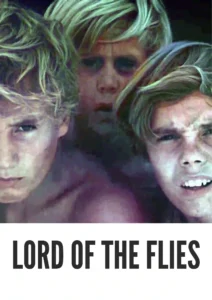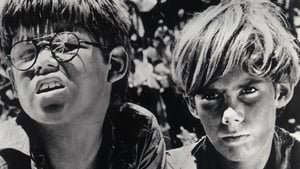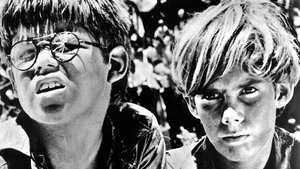Video Sources 0 Views

Synopsis

Experience the chilling adaptation of William Golding’s timeless novel with Lord of the Flies, the 1963 British survival drama, now powerfully colorized to amplify its raw emotional impact. Directed by Peter Brook, this film plunges viewers into a harrowing exploration of human nature, as a group of schoolboys stranded on a deserted island descends into primal chaos. Featuring a cast of non-professional actors, including James Aubrey as Ralph, the film offers an unflinching look at the fragility of civilization and the darkness that lurks within us all. This HD download is a must-see for those seeking a thought-provoking and visually stunning cinematic journey.
Lord of the Flies unfolds as a group of British schoolboys are evacuated from England during an unidentified war. Their plane crashes near a remote, uninhabited island, leaving them to fend for themselves. Initially, they attempt to establish a civilized society, electing Ralph as their leader and using a conch shell as a symbol of order and democracy.
However, as time passes and rescue seems increasingly unlikely, the boys’ primal instincts begin to surface. Jack, a charismatic but power-hungry choirboy, challenges Ralph’s authority, appealing to the boys’ desires for hunting, freedom, and excitement. Gradually, the group splits into two factions: Ralph’s, who strive to maintain order and hope for rescue, and Jack’s, who embrace savagery and violence.
As fear and superstition take hold, the boys begin to believe in a mythical “beast” lurking on the island. This imagined threat fuels their paranoia and drives them further into barbarism. Simon, a gentle and insightful boy, discovers the truth about the “beast,” but his attempt to share his knowledge ends in tragedy when he is mistaken for the creature and brutally murdered.
The film culminates in a descent into complete chaos, as Jack’s tribe hunts Ralph like an animal. Just as Ralph is about to meet his demise, a British naval officer arrives on the island, bringing an abrupt end to the boys’ savage existence. The film concludes with Ralph weeping over the loss of innocence and the realization of humanity’s inherent capacity for evil.
The film features a cast of non-professional actors, lending an air of authenticity to their portrayals:
-
James Aubrey as Ralph
-
Tom Chapin as Jack
-
Hugh Edwards as Piggy
-
Roger Elwin as Roger
-
Tom Gaman as Simon
Lord of the Flies is a survival drama that delves into themes of morality, civility, and the inherent savagery of human nature. It blends elements of adventure, psychological thriller, and social commentary to create a powerful and unsettling cinematic experience.
Released in 1963, Lord of the Flies was one of the first film adaptations of William Golding’s acclaimed novel. The film was groundbreaking for its use of non-professional actors and its unflinching portrayal of violence and primal instincts. It remains a significant work in the history of film adaptation, sparking debate about the nature of humanity and the fragility of civilization.
This colorized version of Lord of the Flies offers a fresh perspective on a timeless classic, enhancing the visual impact and bringing new depth to the characters and settings. The colorization process involved careful consideration of the film’s themes and atmosphere, with the goal of amplifying the emotional resonance of each scene. While some may debate the merits of colorizing classic films, it serves to introduce this important work to new audiences and ensure its continued relevance for generations to come.
-
: Peter Brook
-
: Peter Brook, William Golding (novel)
-
: Tom Hollyman
-
: Peter Brook, Gerald Feil, Jean-Claude Lubtchansky
-
: Lewis M. Allen
-
: 90 minutes
-
: MP4
-
: HD (1080p)
-
: Compatible with most devices, including smartphones, tablets, computers, and smart TVs.
Lord of the Flies (1963) has been praised for its faithfulness to Golding’s novel, its powerful performances, and its unflinching portrayal of human nature. While some critics have found the film to be bleak and disturbing, it remains a highly influential work, sparking discussion and debate about its themes for decades.
-
: What is Lord of the Flies about?
-
A: Lord of the Flies is a survival drama about a group of schoolboys stranded on a deserted island who descend into savagery and violence.
-
-
: Is Lord of the Flies (1963) a faithful adaptation of the novel?
-
A: Yes, the film is generally considered to be a faithful adaptation of William Golding’s novel.
-
-
: Is this version of Lord of the Flies colorized?
-
A: Yes, this version has been professionally colorized to enhance the viewing experience.
-
-
: What makes Lord of the Flies interesting for film fans?
-
A: Lord of the Flies offers a thought-provoking exploration of human nature, featuring powerful performances and a chilling narrative.
-
-
: What is the download format?
-
A: The download format is MP4, which is compatible with most devices.
-
-
: What resolution is the download?
-
A: The resolution is HD (1080p), providing a high-quality viewing experience.
-
Watch Lord of the Flies Today!





